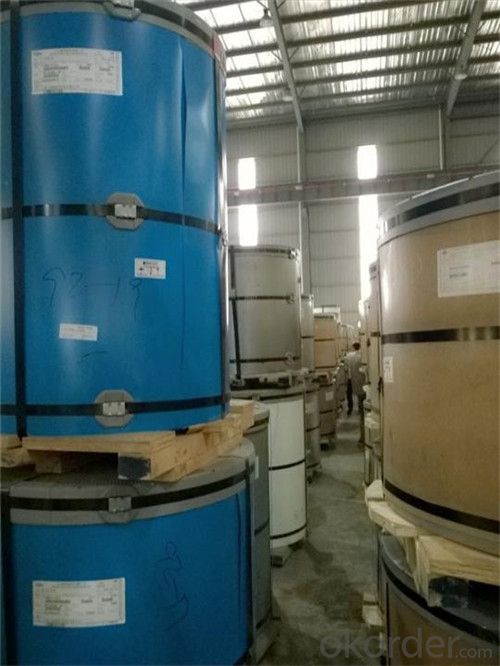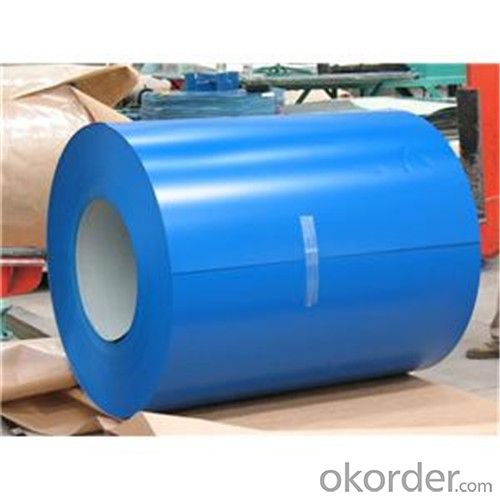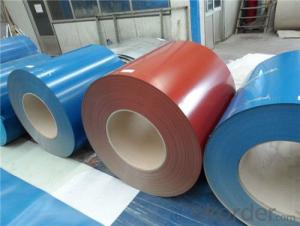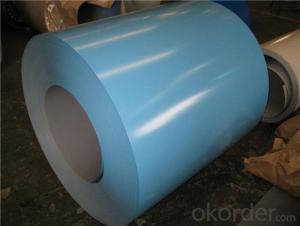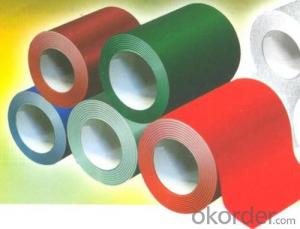Prepainted Rolled steel Coil for Construction roofing Constrution
- Loading Port:
- Shanghai
- Payment Terms:
- TT OR LC
- Min Order Qty:
- 50 m.t.
- Supply Capability:
- 30000 m.t./month
OKorder Service Pledge
OKorder Financial Service
You Might Also Like
Structure of Prepainted Rolled steel Coil for Construction Roofing

Description of Prepainted Rolled steel Coil for Construction Roofing
Prepainted Rolled steel Coil is a kind of coated steel coil/sheet. With the cold rolled steel of different strength and thickness as substrate, it is produced through applying Al-Zn coat on both faces by hot dip process. In its coating, Al accounts for about 55%, Si 1.6%, while the remaining is Zn. Aluminum zinc coils enjoys both the physical protective feature and durability of Al and the electrochemical protective property of Zn. And its surface has bright silver color and regular embossed-like figure, which are highly decorative.
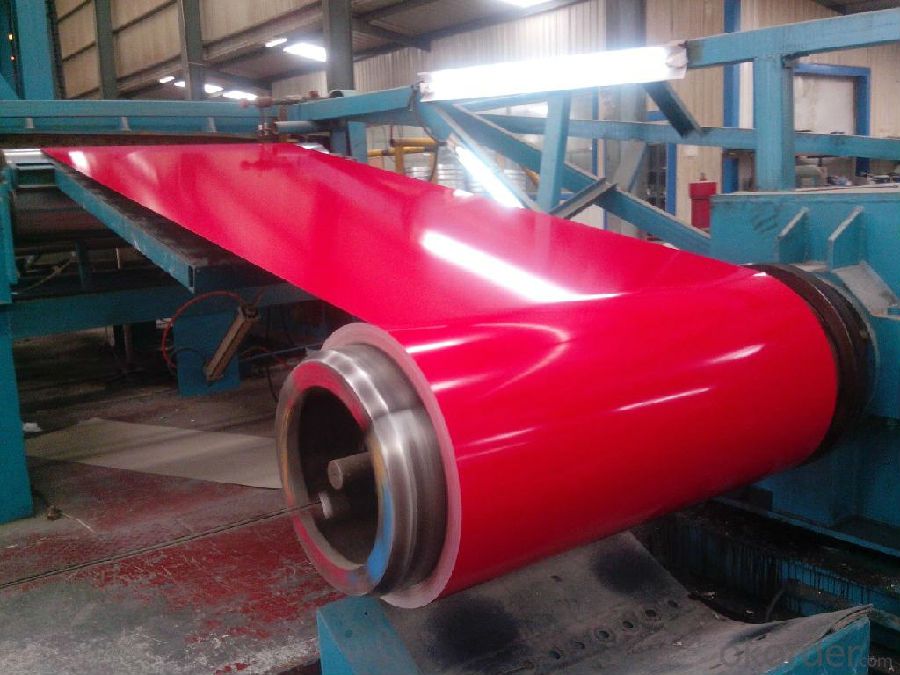


Main Feature of Prepainted Rolled steel Coil for Construction Roofing
1.Corrosion resistance: It mainly depends on the aluminum protection. When the zinc being worn, the aluminum will form a dense layer of aluminum oxide, resist corrosion material to prevent further corrosion inside.
2. Heat resistance: Aluminum zinc alloy steel sheet has excellent heat resistance, can withstand high temperatures over 300 centigrade, and is similar with aluminized steel high temperature oxidation resistance. It often used in chimney pipes, ovens, fluorescent lighting device and the device cover.
3. Heat reflective: Galvanized steel plate heat-reflective high rate is twice as galvanized steel, often used to make insulation materials.
4. Economy: Because density of 55% AL-Zn is smaller than the density of Zn, so in the same weight and thickness of Galvanized zinc layer, aluminum-zinc steel plate is larger area more than 3% of galvanized steel sheet.
Applications of Prepainted Rolled steel Coil for Construction Roofing
1. Construction and building: roofing; ventilating duct; handrail; partition panel;etc.
2. Electric appliance: refrigerator; washing machine; refrigerator; DVD;etc.
3.Transportation: oil tank; road sign; etc.
4.Agriculture:barn; etc.
5.Others:vending machine; game machine; etc.


Specifications of Rolled steel Coil for Construction Roofing
Product | Prepainted Rolled steel Coil for Construction Roofing |
Material Grade | SGCC / SGCH / DX51D+AZ, etc |
Thickness | 0.2-3.0mm |
Width | 600-1500mm |
Tolerance | Thickness: +/-0.02mm , Width:+/-2mm |
Zinc-coating | AZ40-150g/m2 |
Technique | Raw material: Hot rolled steel coil --> Cold rolled_>hot dipped galvalume |
Surface | Dried, Chromated, Unoiled |
Spangle | Regular spangle , small spangle, zero spangle |
ID | 508MM |
Coil weight | 10MT max |
Export package | Cardboard inner sleeves, Waterproof paper, galvanized steel covered and steel strip packed |
FAQ of Prepainted Rolled steel Coil for Construction Roofing
We have organized several common questions for our clients,may help you sincerely:
1. What is the minimum order quantity ?
Our MOQ is 50mt for each size. And we will consider to give more discount if you make big order like 1000 tons and more. Further more, the more appropriate payment term your offer the better price we can provide.
2. How long can we receive the product after purchase?
Usually within thirty working days after receiving buyer’s advance payment or LC. We will arrange the factory manufacturing as soon as possible. The cargo readiness usually takes 15-25 days, but the shipment will depend on the vessel situation.
3. How to guarantee the quality of the products?
We have established the international advanced quality management system,every link from raw material to final product we have strict quality test;We resolutely put an end to unqualified products flowing into the market. At the same time, we will provide necessary follow-up service assurance.
- Q: What are the different types of steel coil packaging materials used during processing?
- Some of the different types of steel coil packaging materials used during processing include steel strapping, plastic strapping, stretch film, shrink wrap, and coil covers.
- Q: What are the common applications of hot-dip galvanized steel coils?
- Hot-dip galvanized steel coils have a wide range of applications due to their excellent corrosion resistance and durability. Some of the common applications of hot-dip galvanized steel coils include: 1. Construction: Hot-dip galvanized steel coils are extensively used in the construction industry for various applications such as roofing, siding, gutters, and downspouts. The corrosion resistance of these coils makes them ideal for withstanding harsh weather conditions, ensuring long-lasting and low-maintenance structures. 2. Automotive: Hot-dip galvanized steel coils are widely used in the automotive industry for manufacturing parts like body panels, frames, chassis, and structural components. The corrosion resistance and high strength of these coils provide enhanced protection against rust and ensure the longevity of automotive parts. 3. Appliances: Hot-dip galvanized steel coils find applications in the manufacturing of various household appliances such as refrigerators, air conditioners, ovens, and washing machines. The corrosion resistance and aesthetic appeal of galvanized steel make it an ideal choice for these appliances. 4. Agriculture: Hot-dip galvanized steel coils are commonly used in the agricultural sector for building greenhouses, livestock shelters, fences, and irrigation systems. The galvanized coating protects the steel from corrosion caused by exposure to moisture and chemicals commonly found in agricultural settings. 5. Electrical and Telecommunication: Hot-dip galvanized steel coils are utilized in the electrical and telecommunication industries for the production of transmission towers, poles, cable trays, and electrical conduits. The corrosion resistance and high strength of galvanized steel ensure the safety and reliability of these infrastructure components. 6. Transportation: Hot-dip galvanized steel coils are extensively used in the transportation industry for manufacturing trailers, shipping containers, and chassis components. The galvanized coating provides protection against corrosion caused by exposure to road salt, moisture, and various environmental factors. 7. Industrial Applications: Hot-dip galvanized steel coils are employed in various industrial applications such as storage tanks, pipelines, ductwork, and industrial equipment. The corrosion resistance and durability of galvanized steel ensure the integrity and longevity of these structures and equipment. In summary, the common applications of hot-dip galvanized steel coils encompass a wide range of industries, including construction, automotive, appliances, agriculture, electrical and telecommunication, transportation, and industrial sectors. The corrosion resistance, durability, and aesthetic appeal of galvanized steel make it a versatile and widely used material in these applications.
- Q: How are steel coils used in the production of electrical motors?
- Steel coils are used in the production of electrical motors as they serve as the core component of the motor's electromagnetic system. These coils are wrapped around an iron core, creating an electromagnetic field when electricity flows through them. This electromagnetic field generates the necessary force that allows the motor to convert electrical energy into mechanical energy, enabling the motor to function and perform various tasks.
- Q: What is the cost of a steel coil?
- The cost of a steel coil can vary depending on factors such as the type and grade of steel, the size and weight of the coil, and market conditions. It is best to contact a supplier or manufacturer for accurate pricing information.
- Q: What are the major global steel coil markets?
- The major global steel coil markets are primarily concentrated in regions with significant industrial and manufacturing sectors. Some of the key markets include North America, Europe, and Asia-Pacific. North America, particularly the United States, is a major steel coil market due to its large automotive industry and construction sector. The demand for steel coil in this region is driven by the production of automobiles, infrastructure development, and residential construction. Europe is another significant market for steel coil, with countries like Germany, Italy, and France being major consumers. The automotive industry, construction sector, and machinery manufacturing contribute to the demand for steel coil in this region. Asia-Pacific, specifically China, is the largest market for steel coil globally. China's booming economy, rapid urbanization, and infrastructure development have led to a massive demand for steel coil. Other countries in the region, such as Japan, South Korea, and India, also have substantial steel coil markets due to their industrial and construction activities. Additionally, emerging markets in Latin America, the Middle East, and Africa are witnessing increasing demand for steel coil. These regions are experiencing economic growth and urbanization, leading to a rise in construction and infrastructure projects. Overall, the major global steel coil markets are driven by industrial and manufacturing activities, infrastructure development, and construction projects in various regions around the world.
- Q: How are steel coils used in the production of automotive suspension systems?
- Steel coils are used in the production of automotive suspension systems as they provide the necessary support and flexibility to absorb shocks and vibrations. These coils are typically used in the construction of coil springs, which are then integrated into the suspension system to ensure a smooth and comfortable ride for the vehicle.
- Q: Can steel coils be coated with impact-resistant materials?
- Yes, steel coils can be coated with impact-resistant materials. These coatings provide an additional layer of protection to the steel coils, making them more resistant to impact damage.
- Q: What is the difference between a steel strip and a coil? The steel strip is flat steel, and the steel coil is made of steel. Is that correct?
- Steel rolls are also called steel belts. There is no difference between them. They are not flat steel
- Q: I just got a set of all-clad Stainless steel frying pans, they are very nice yet they didn't come w/ instructions to care for them. I have never cooked w/ stainless steel cookware so I really don't know much about them. I was told they should have a lifetime warranty on them, but I don't want to reck them. I would appreciate any information I can get on stainless steel cookware. Thanks.
- I bought a badly scratched-up 11 inch All-Clad Frying pan off Ebay for $23.00. I needed a large all-clad frying pan. I took it out to the garage and first cleaned it with an 8 wire brush on my bench-top polishing / grinding machine. Then I installed a 8 polishing wheel on the bench grinder. I used some polishing creme I use on car parts that I bought from Caswell s Plating. Auto polishing for your car will work too. The outside polished up like a mirror - as good as my new All-Clad pieces. Remember people. This is stainless steel. It s a tough, tough metal. You can work it like a piece of metal just as All-Clad did at the factory where they made it. It would take years to wear through the first stainless layer with a polishing wheel and mild auto polishing creme just as it would take a lot to wear through your cars paint. After-all; All you are doing is preparing an optical surface.
- Q: i heard steel type is good and i don't have any i have defeated all the trainers up to the icicle badge (i have got the icicle badge but not the one after) where can i get one?
- lucario is both fighting and steel if you got piplup, empoleon is water and steel, if you happen to have a shieldon (only in pearl) he is ground and steel. Bronzor and bronzong are both psychic and steel you can find them in wayward cave is the easiest place that is under cycling road Steelix is in victory road but i guess you aren't there yet hehehe.... aside from dialga, who is dragon and steel i think those are it, unless you have any others like heatran or magenezone sorry i can't help much Oh but I can trade a steeliz if you want? my name is JAY my fc is 1375.4387.9544 =D
Send your message to us
Prepainted Rolled steel Coil for Construction roofing Constrution
- Loading Port:
- Shanghai
- Payment Terms:
- TT OR LC
- Min Order Qty:
- 50 m.t.
- Supply Capability:
- 30000 m.t./month
OKorder Service Pledge
OKorder Financial Service
Similar products
Hot products
Hot Searches
Related keywords





